| Every
new release of openSUSE is
always welcomed with great interest from the Linux community as it is
without any doubt one of the leading distributions. And it is a leading
distribution as besides introducing exiting new technologies and
presenting a polished Linux environment, it also has a huge user base,
probably second only to Ubuntu. |
The innovations openSUSE and Novell have brought to the Linux world since then are many, however I will stick to what is offered with openSUSE 10.3, especially in the desktop user area. This review was delayed for about a week as I decided to use openSUSE a bit more before I wrote my thoughts, attempting to be as fair as possible since when I first downloaded and installed 10.3 there was not even a release announcement out so there could be some small problems because the distro was too new.

Installation
For the first time except the DVD that includes almost everything (and weights about 4.1GB), openSUSE also released single installation CDs, one for Gnome and one for KDE. I decided to try one of those, as it will probably be the choice of the most users instead of the DVD. I puzzled a bit wondering which of the KDE or Gnome desktops I should try first and finally concluded using the Gnome version so that I can judge openSUSE better since I am a Gnome user for the past 2 years myself. Also Gnome is being used for SUSE Enterprise Desktop (Novel's commercial Linux based on openSUSE) so I thought it would be more polished. What is left for another article would be trying the KDE desktop as well and doing a small comparison!
{mostip image=info}You can download openSUSE from the project's homepage here. The Distrowatch page can be found here.{/mostip}
The installer is the one we know from the past SUSE versions. It offers excellent hardware detection and easy wizards to setup any aspect of the installation you will imagine. Beginners may find it too complicated at start, especially when you compare it with the very simple installers others distros offer, but there are instructions and help for about everything.
There is also an option to add online repositories before the installation which is great in order to add source for stuff that cannot is not in the CD or cannot added there, for example nVidia drivers, codecs and other non-OSS stuff. However keep in mind that downloading these will slow down your installation (it can take several hours if you select many packages and apply updates) so you can just install them afterwards easily enough. Another great thought from the openSUSE people that I should mention is that they offer a CD containing all the non-OSS packages you may need in order to use them at a PC that does not have an Internet connection.
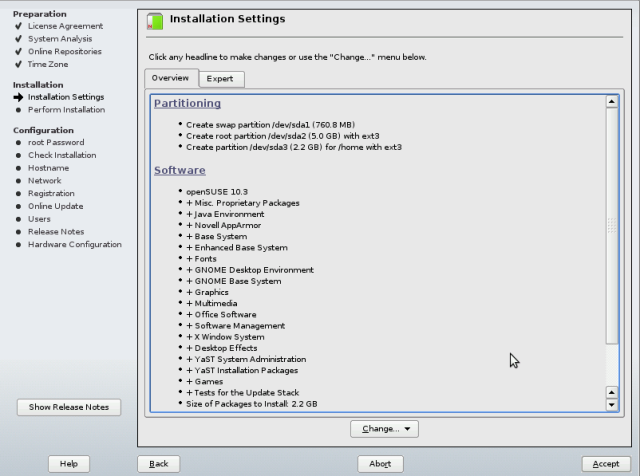 |
| openSUSE installer. |
Usage
First Impressions
After installation you will probably notice that the boot process takes less time than older versions. OpenSUSE developers claim to have made 10.3 boot at least twice as fast as before, and I can say that they are right. They also claim to have a new "Beautiful Green Artwork" and once again cannot disagree! The artwork looks very polished and professional and you could say openSUSE 10.3 is one of the most beautiful distros out there. You can see every piece of the new artwork in detail here.
Configuration & Package Management
openSUSE uses YaST, which is probably the best Linux control panel. YaST takes care of every configuration option the user might imagine, from setting the display or network settings to configuring your TV card or setting up a joystick. The amount of configuration options in YaST is enormous, meaning you will almost never need to use the command line to setup something. For example, I always have trouble trying to set my resolution (1680x1050) at most distros, but in openSUSE it is two clicks away. At the same time the way the information is presented makes it easy even for the beginner to use. An important improvement that was introduced with openSUSE 10.3 is the GTK version of YaST, which means that it will still have a well-integrated and consistent feel when using Gnome, as opposed to previous versions where it was just using Qt. However I continue to have the feeling that YaST is a bit slow. Sure there are improvements in speed, but the lag between clicking an option and seeing the dialog window is still there. Besides that, as I mentioned for Linux Mint last week, I disagree with the appearance of configuration modules both in Gnome Control Center and in YaST when it is the same thing (and opens the same window) as it confuses the users without a reason.
The package format openSUSE uses is RPM and management is being done by YaST or zypper if you prefer command line. In the backend of package management, ZENworks has been replaced by the new libzypp and its tools, resolving the problems many users have been mentioning in the previous versions of openSUSE, and dramatically improving speed. A great addition is the new "Community Repositories" YaST module which makes adding extra repositories a matter of a few clicks. No need to hunt down what repos you need to add in order to install something that is not available in the official one, all the popular repositories (like Packman for example) can now be enabled easily. However accessing the repositories (all of them) continues to be very slow, it needed over 10 minutes to download the cache of the packages available. I am not sure if it was due to the mirror being slow (I tried downloading a single file from Firefox and it was fast), but the openSUSE developers need to see the speed of package managers like apt-get and improve their offering.
Generally package management seems very improved in openSUSE 10.3 both in terms of simplicity and speed. Especially with the new "1-Click Install" technology we will mention right below. Unfortunately some problems continue to exist, for example when installing something the YaST progress window will pop-up every once and a while during the installation disturbing the user. I could also add that there is a need for a better graphical package management than the one available right now.
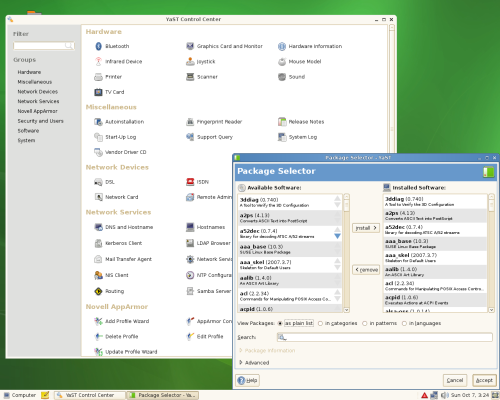 |
| YaST is impressive, and the new GTK version looks good, however the package selector can be improved. (click for full size image) |
nVidia drivers were easy to install using the repositories, and of course very easy to enable using YaST. As one might expect, activating Compiz was simple as well while it also proved to be very stable, suggesting that it is at least ready to be included and activated by default in supported hardware.
Multimedia / Applications
I think that the best way to test the new "1-Click Install" technology would be by installing multimedia codecs. As we can read in the release announcement "This is a completely new and revolutionary piece of technology available to you in openSUSE, which finally removes the hassle from installing additional software from other repositories. Instead of searching for a repository, adding it to the package manager, then heading over to software management again, 1-Click-Install combines it into one simple process, all initiated by a single click.".
As always openSUSE does not ship with multimedia codecs or proprietary programs, Flash, Java and other non open source stuff so I decided to give it a try in order to test 1-Click-Install. So I tried to open an XviD video file with Mp3 audio using Totem player which informed me that I need to install extra codec to play this file. Clicking OK opened Firefox which offered me a selection depending on which desktop environment I use, Gnome or KDE. Clicking on Gnome opened an easy wizard which installed automatically everything I could ever need: Fluendo Mp3 decoder, Flash, Java and win32codecs.
I found a bit extreme installing everything that way (a user may not want w32codecs or Java, but instead only mp3 and Flash for example), but there is an "advanced mode" that will allow you to select what to install.
Summing up, 1-Click-Install is an excellent addition to openSUSE, making the once complicated instructions you needed to follow to install these non-OSS packages easier than ever. No need to care about extra repositories or worrying which exact packages you need to install. And of course I am pretty sure that there will be many more uses for this tool in the future.
After installing the necessary codecs everything played correctly. openSUSE uses the latest Gnome 2.20 and defaults to Totem for video playback and Banshee player for music playback / management. Mozilla Firefox is the browser, Evolution the mail client and Liferea is the RSS reader. OpenOffice.org is the office suite, F-Spot is installed for image browsing and Pidgin is the Internet messenger. The Linux kernel included is 2.6.22. As you understand there are no surprises in the software selection, at least in the Gnome CD.
openSUSE does not follow the standard Gnome setup, instead it only uses one bar at the bottom, containing the menu, Tomboy notes next to it and the system tray at the other end followed by the date/time and the "show desktop" button. Strangely enough the Workspace switcher is not there by default. One thing that I disliked is the menu, known as SLED menu. I can understand that some people feel comfortable with it and that it looks pretty cool, but in my opinion showing just 9 applications (the most frequently used ones) and opening a new window (not a submenu, a full window called Application Browser - you can see it in the screenshot below) is a bad choice in terms of usability. I could only live with it for a few days, and then removed it and added the default Gnome menu.
Updates
openSUSE 10.3 features a new update tool which you can see in the screenshot below.
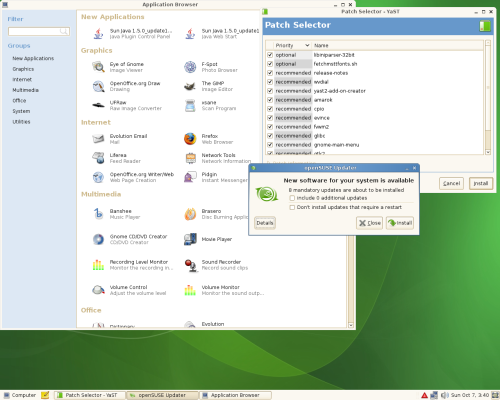 |
| The new update tool. (click for full size image) |
That combination of notification icon and update tool, makes the important task of fetching updates easier than previous versions of openSUSE. Updates seem to be categorized in two categories, "mandatory" and "additional", however the vast majority I have encountered so far are mandatory ones (24 to 2).
Conclusion
The final feeling I got after using openSUSE for about two weeks was definitely a positive one. openSUSE 10.3 is much better than its predecessor and quite possibly the best openSUSE release so far. It really looks and behaves like a professional quality polished product. The nice and clean theme, the improved YaST, even the new design of their website put openSUSE in a complete different league than the most distros out there, you can see that this is the free edition of a product Novell has invested money and time into. Surely for many users this may not mean much, however for someone new to Linux openSUSE 10.3 is probably the best distribution to try.
From a plain user's point of view, I didn't really experienced any serious problems besides the minor annoyances I described above. The applications selection is pretty standard, package installation and management is adequate and the system is stable and fast. Experienced users may notice a bit loss of speed compared to other distros or they may dislike YaST messing their system settings up, but openSUSE just doesn't target that user group. I'd highly recommend openSUSE to everyone.


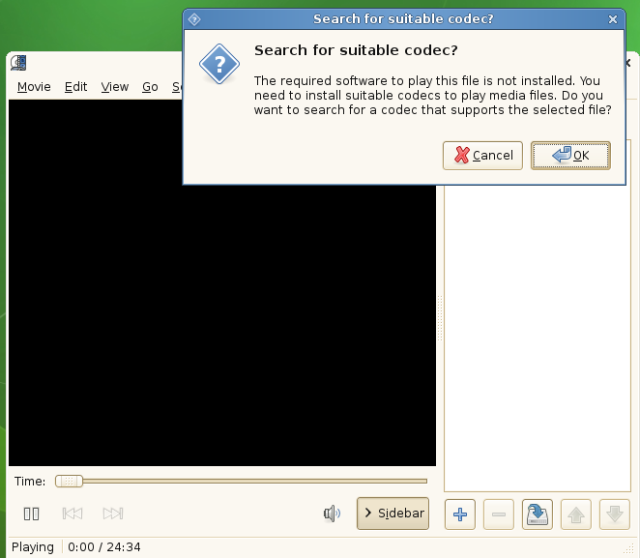
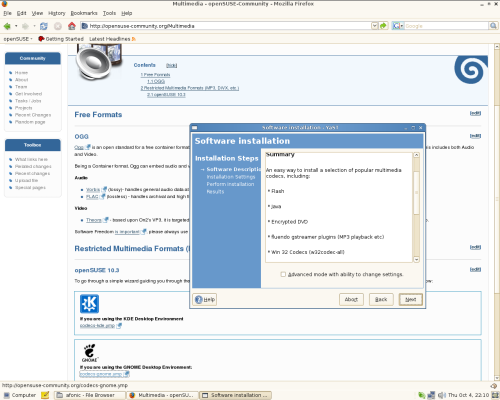
Comments
Cheers
Does 1-Click-Install make it possible to play midi files from Firefox? Or make it possible to download a midi file and play it with Amarok or some other easy-to-use player? In the past, I read that it was easier to configure midi (timidity) on SUSE than on some other leading full-feature distros. It was still over my head.